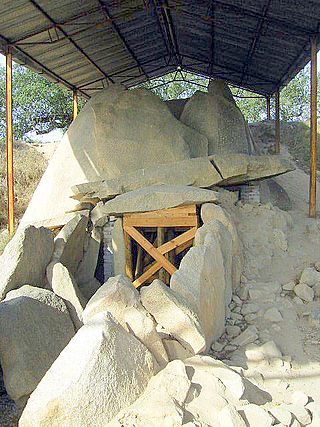
Great Dolmen of Zambujeiro is a megalithic monument located in Nossa Senhora da Tourega, near Valverde, in the municipality of Évora, considered one of the biggest such structures in the Iberian Peninsula.

The Sieben Steinhäuser is a group of five dolmens on the Lüneburg Heath in the NATO training area of Bergen-Hohne, in the state of Lower Saxony in northern Germany. The stones are considered to be part of the funnelbeaker culture. The gravesite was granted protected cultural monument status in 1923.
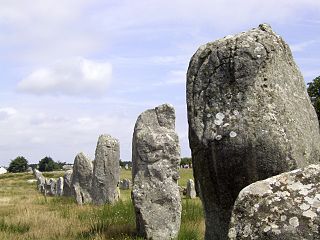
The Carnac stones are an exceptionally dense collection of megalithic sites near the south coast of Brittany in northwestern France, consisting of stone alignments (rows), dolmens, tumuli and single menhirs. More than 3,000 prehistoric standing stones were hewn from local granite and erected by the pre-Celtic people of Brittany and form the largest such collection in the world. Most of the stones are within the Breton municipality of Carnac, but some to the east are within neighboring La Trinité-sur-Mer. The stones were erected at some stage during the Neolithic period, probably around 3300 BC, but some may date to as early as 4500 BC.

The Dolmen of Menga is a megalithic burial mound called a tumulus, a long barrow form of dolmen, dating from 3750–3650 BCE approximately. It is near Antequera, Málaga, Spain.

The Tumulus of Bougon or Necropolis of Bougon is a group of five Neolithic barrows located in Bougon, near La-Mothe-Saint-Héray, between Exoudon and Pamproux in Nouvelle-Aquitaine, France.

The Oldendorfer Totenstatt is a group of six burial mounds and megalith sites in Oldendorf north of Amelinghausen in the valley of the River Luhe in Lüneburg district in the German state of Lower Saxony. It consists of dolmens and tumuli.

The Dolmen de Viera or Dolmen de los Hermanos Viera is a dolmen—a type of single-chamber megalithic tomb—located in Antequera, province of Málaga, Andalusia, Spain. It is located only 70 metres (230 ft) from the Dolmen de Menga and about 4 kilometres (2.5 mi) of another structure known as Tholos de El Romeral. It was discovered between 1903 and 1905 by brothers Antonio and José Viera from Antequera, who also discovered El Romeral.

The Dolmen of Cunha Baixa is a dolmen in the civil parish of Cunha Baixa, in the municipality of Mangualde. It is located in a valley area of the Rio Castelo, between the villages of Cunha Baixa and Espinho.
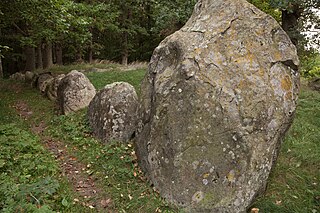
The Great dolmen of Dwasieden, is a great dolmen in the borough of Sassnitz, on the Jasmund peninsula of Germany's largest island, Rügen. It was excavated in 1970 by Ewald Schuldt and is designated a Sprockhoff No. 472. The megalithic site of the Funnelbeaker culture (TBK) was constructed between 3500 and 2800 BC.

Nordic megalith architecture is an ancient architectural style found in Northern Europe, especially Scandinavia and North Germany, that involves large slabs of stone arranged to form a structure. It emerged in northern Europe, predominantly between 3500 and 2800 BC. It was primarily a product of the Funnelbeaker culture. Between 1964 and 1974, Ewald Schuldt in Mecklenburg-Western Pomerania excavated over 100 sites of different types: simple dolmens, extended dolmens, passage graves, great dolmens, unchambered long barrows, and stone cists. In addition, there are polygonal dolmens and types that emerged later, for example, the Grabkiste and Röse. This nomenclature, which specifically derives from the German, is not used in Scandinavia where these sites are categorised by other, more general, terms, as dolmens, passage graves and stone cists.

The simple dolmen or primeval dolmen is an early form of dolmen or megalithic tomb that occurs especially in Northern Europe. The term was defined by archaeologist, Ernst Sprockhoff, and utilised by Ewald Schuldt in publicising his excavation of 106 megalithic sites in the north German state of Mecklenburg-Vorpommern. The simple dolmen emerged in the early days of the development of megalithic monuments of the Funnelbeaker culture (TBK) and around 3,500 BC they appeared across almost the entire region covered by the stone cult structures of Nordic megalith architecture, but not in the Netherlands, in Lower Saxony west of the River Weser nor east of the River Oder and only once in Sweden.

A rectangular dolmen, extended dolmen or enlarged dolmen is a specific type of megalith, rectangular in shape, with upright sidestones and, usually, two capstones. The term rectangular dolmen was coined by Ekkehard Aner and is used especially in the German state of Schleswig-Holstein, where dolmens with this type of ground plan primarily occur. A more precise term, however, is extended dolmen, used by Ewald Schuldt and Ernst Sprockhoff, because these types of dolmen also occur with trapezoidal ground plans.
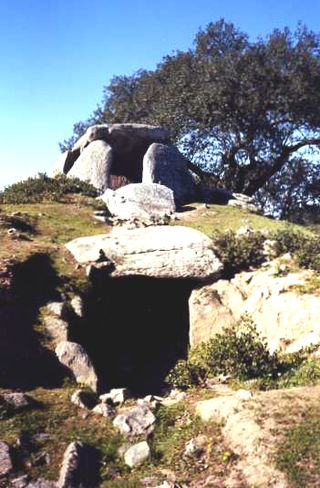
The Great Dolmen of Comenda da Igreja is a megalithic funerary site in the civil parish of Nossa Senhora do Bispo, in the municipality of Montemor-o-Novo, in the central Alentejo region of continental Portugal.

The dolmen del prado de Lácara is a megalithic monument known as a passage tomb. It is located northwest of the Spanish city of Mérida, in the province of Badajoz. It is located next to the EX-214 road, which connects Aljucén with La Nava de Santiago. It is a notable megalithic tomb, built during the late Neolithic towards the end of the 4th millennium BC or early 3rd millennium BC. It is one of the most monumental and well preserved sites in the Extremadura region, which is why it was declared a site of cultural interest in 1912 and a National Monument in 1931.

Tholos de El Romeral, situated 2.5 kilometres (1.6 mi) north east of the town of Antequera (Andalusia), is one of the most important examples of early Bronze Age architecture in southern Europe. Tholos de El Romeral, also known as Cueva de Romeral and Dolmen de Romeral, is a megalithic burial site built circa 1800 BCE. It is one of three tombs in region, the others being Dolmen de Menga and Dolmen de Viera, both situated to the south west.
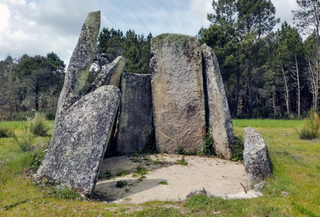
Dolmen of Carapito I is a megalithic monument located in the civil parish of Carapito, in the municipality of Aguiar da Beira in the Guarda District of Portugal.

The Dolmen of Guadalperal, also known as the treasure of Guadalperal and as the Spanish Stonehenge for its resemblance to the English Stonehenge, is a megalithic monument dating from between 2000 and 3000 BC in Peraleda de la Mata, a town in the region of Campo Arañuelo in eastern Extremadura, Spain. The monument is within the Valdecañas reservoir in the Tagus River and is only visible when the water level allows it.

The Déhus dolmen is a Neolithic dolmen located in the parish of Clos du Valle on the island of Guernsey.

The Antas do Olival da Pêga are located near the village of Telheiro, in the municipality of Reguengos de Monsaraz, in the Évora district of the Alentejo region of Portugal. Anta is the Portuguese name for a dolmen, a single-chamber megalithic tomb. These two neolithic dolmens were used over a long period, from the late neolithic to the chalcolithic. The tombs were originally identified by the German archaeologists, Georg and Vera Leisner, who excavated Anta 1, with Anta 2 being subsequently excavated from the 1990s by Victor Gonçalves and Ana Catarina Sousa of the Centre of Archaeology of the University of Lisbon (UNIARQ). In addition to the visible stones at the two sites, which are about 300 meters apart, many items have been found as a result of excavations. Over one hundred people were buried in each tomb. The proximity of the two tombs gives rise to the conclusion that both were part of the same megalithic complex.

The Dolmen de Soto is a Neolithic subterranean structure in Trigueros, Andalucía, Spain. It is estimated it was built between 4,500 and 5,000 years ago and is one of about 200 neolithic ritual-burial sites in the province of Huelva.




















